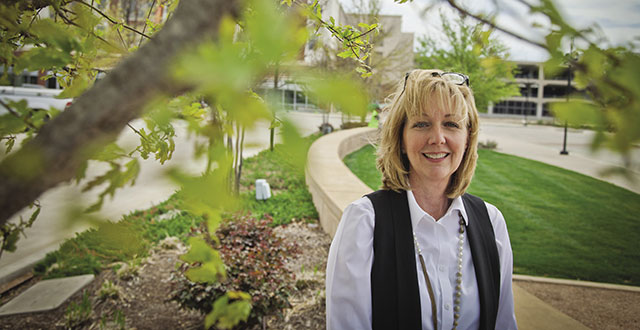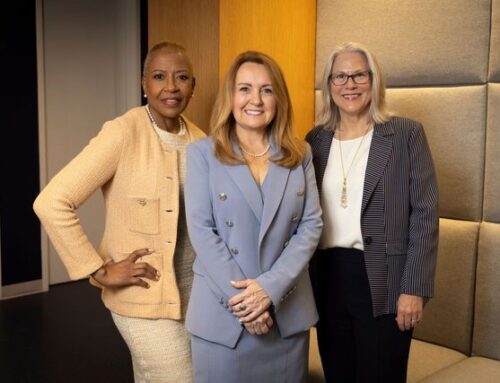
Executive director of the Lake Highlands Public Improvement District Kathy Stewart: Photo by Kim Leeson
Several years ago when developers began planning the Lake Highlands Town Center, they initiated the process of creating a Public Improvement District, commonly known as a PID, around the property. A PID, an agreement between landowners and local government, provides an avenue for the improvement of infrastructure, safety and economic growth in an established area. While Lake Highlands boasts a wealth of beautiful homes, parks and trails, reputable schools and development potential, it also includes plenty of problematic apartment and condominium properties, families living in poverty, sketchy businesses and high-crime hotspots, which are some of the reasons a PID arguably was in order. In the six years since the LHPID inception, significant relationships among apartment managers and representatives of the PID and government have been forged, crime has dropped and aesthetics have improved. Recently the PID’s executive director, Becky Range, transferred to the nearby Vickery Meadow PID, and neighborhood resident Kathy Stewart — attorney, mother of three adult children and former owner of Highlands Café — was appointed executive director of the LHPID. Six weeks in, her plate is piled high with tasks, but she took time to answer a few of our more pressing questions.
How do you explain a PID and your job to the average person?
The property owners in a specific neighborhood decide whether they want a Public Improvement District. Basically, if 60 percent of property owners vote for the PID [they also must represent at least 60 percent of the value of the property in the district] the City of Dallas approves its formation. Then property owners are assessed a tax [not to exceed 15 cents per $100 of property value]. The money is collected and given to the PID for disbursement, which is determined by a specific budget, with oversight by the City, and annual audits. Fifty percent of the funds are locked into public safety. The rest goes to things like park and infrastructure improvements, community-building events and publicity. So basically, I work for the property owners and with the PID Board of Directors, which is made up of 10 volunteer community leaders and property owners. My responsibilities include establishing relationships with local leaders, Dallas Police, community prosecutors and property owners; ensuring certain irrigation systems are working and that trash and graffiti are cleaned up; planning events; problem solving and envisioning capital improvements. It is a multifaceted position with many moving parts … and I love it. The PID comes up for renewal in 2015 and the property owners will have an opportunity to vote again.
[quote align=”right” color=”#000000″]”Crime reports confirm that condos are seeing a great deal of crime even compared to apartment communities, so that is the next phase for us. While we spend a bulk of effort and funds to make the area safer, we also make visible improvements — such as the median at Skillman near Church — and cleaning up, trimming trees and bushes on park land, along sidewalks and green spaces, eradicating graffiti, hosting events and publicizing the work so that taxpayers understand what they are getting.”[/quote]Where is the LHPID?
Our PID encompasses about 500 acres along the Skillman corridor from LBJ on the north end down to Skillman and Abrams on the south.
What are the major challenges of the LHPID?
The area is home to thousands of apartments — that type of density often results in crime and quality-of-life problems. My predecessor, Becky Range, created a new standard of communication among police, City Councilman Jerry Allen, apartment owners/managers, community prosecutor Patrick Sanders and social nonprofits, to name a few, and the result has been more action, more results when it comes to improving the apartments and making them safer. So one thing is to keep up the momentum there. Success depends on all those people and groups working together, and I expect it to continue.
Some of the specific actions include hiring off-duty police to patrol properties, educating apartment owners about background checks and eviction for bad behaviors, and working with established nonprofit groups like Kids-U [an after-school program for children living in apartments]. However, what we have found is that when you kick the bad actors out of the apartments, they often move into condos. Becky, who now directs the Vickery Meadow Public Improvement District, and I are putting together a workshop for condominium owners. Condos present a special challenge because there are many different owners, and thus it is more difficult to affect sweeping change. Crime reports confirm that condos are seeing a great deal of crime even compared to apartment communities, so that is the next phase for us. While we spend a bulk of effort and funds to make the area safer, we also make visible improvements — such as the median at Skillman near Church — and cleaning up, trimming trees and bushes on park land, along sidewalks and green spaces, eradicating graffiti, hosting events and publicizing the work so that taxpayers understand what they are getting.
So it is fair to say the main purpose of a PID is safety and crime reduction?
Well, I would say it is two-fold. It is about that, but it also is about promoting redevelopment and growth, and, though I have just been in this position six weeks. I see that both are very much at work.
Speaking of development and growth, any word on Lake Highlands Town Center retail?
No. No announcements yet, though the Haven Lake Highlands offices are open, they are leasing and they will have a retail tenant — probably restaurant — as part of the development. That quite possibly could be the first thing announced.
Can you give us an example of an area in the city where a PID has made a big difference?
Uptown, Downtown, Deep Ellum, Oak Lawn, Vickery Meadow and University Crossing is on its way.
You mentioned community-building events supported by the PID. Isn’t there one this month?
Yes! Memorial Day, May 26, at Lake Highlands Town Center is the PID-sponsored Art & Play Festival, which shares time and space with the Camp Sweeney 5k. Camp Sweeney is a summer camp for kids with Type 1 diabetes. The 5k is at 8 a.m. followed by the festival featuring artists, food trucks, and lots of activities for families. This is our second year – last year was a big success raising money for many scholarships to Camp Sweeney and bringing 800-1,000 people to Town Center. While the race is a fundraiser, the purpose of the Art & Play festival is to bring our Lake Highlands community together, showcase local artists and raise awareness about the needs of our neighborhood and the PID. Maybe someday our festival will have the great reputation of the Cottonwood Art Festival in Richardson.
Questions and answers are edited for brevity.
Learn more:






